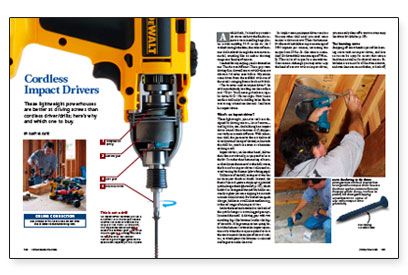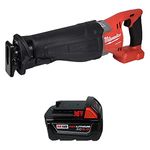Cordless Impact Drivers
These lightweight powerhouses are better at driving screws than cordless driver/drills; here's why and which ones to buy.

Synopsis: In addition to being a comparative survey of nine cordless impact drivers from five manufacturers, this article also describes how to use these versatile, lightweight tools and the various job-site tasks they are well suited for.
A while back, I visited my cousin’s job site to see how the finish carpenters were installing huge plaster crown molding 30 ft. in the air. As I walked through the door, the racket of hammer drills echoed through the cavernous remodel, sounding like an indoor shooting range on a Sunday afternoon.
I reached for my earplugs, and it dawned on me: The din was different. These guys were driving 6-in. drywall screws with little screw shooters I’d never seen before. My cousin came down from the scaffold with one of those tools swinging from a hook on his belt.
“You’ve never used an impact driver?” he said incredulously, handing me the cordless tool. “Try it. You’ll never go back to a regular driver/drill.” He was right. Now I use a cordless drill only for drilling holes. But he was wrong to hand me that tool. I still have his impact driver.
What’s an impact driver?
These lightweight, pint-size tools are designed for driving screws—lots of screws— and lag bolts, too. And although an impact driver sounds like a hammer drill, the percussive force is much different. With a hammer drill, the percussive force is delivered directly toward the tip of the tool, in line with the drill bit, much the same as a hammer striking a nail.
Impact drivers, on the other hand, deliver their force rotationally, or perpendicular to the bit. So rather than hammering a fastener directly into the material as the drill rotates, the force of an impact driver is directed toward turning the fastener.
Unlike a cordless drill, an impact driver has no three-jaw chuck or clutch. Instead, the front of the tool sports a simple spring-loaded quick-change chuck, which holds 1 ⁄4-in. hexagonal bits and bit holders securely in place (no more slipping bits as with a standard drill chuck). But behind the quick changer, hidden in a well-lubricated housing, is the real magic of an impact driver.
Inside the head and attached to the back of the quick changer is a two-lugged gear aptly named the anvil. A driving gear with two matching lugs (the hammer) strikes the lugs of the anvil. A large compression spring behind the hammer initiates the impact operation only when the torque required to turn the screw exceeds the torque of the tool’s motor, at which point the hammer is released and begins to strike the anvil.
In simpler terms, an impact driver runs just like any other drill until you need more torque to drive a screw. Then the hammer hits the anvil and delivers up to an average of 3000 impacts per minute, increasing the torque from 250 in.-lb. (the same as a standard 12v driver/drill) to an average of 700 in.- lb. That’s a lot of torque for a screwdriver. One caution: Although you may never strip the head of a screw with an impact driver you can easily shear off a screw or even snap the driver bit.
For more photos and details, click the View PDF button below:
Fine Homebuilding Recommended Products
Fine Homebuilding receives a commission for items purchased through links on this site, including Amazon Associates and other affiliate advertising programs.

Milwaukee 18v Cordless Reciprocating Saw (2720)

DEWALT 18v Cordless Multitool (DCS355)

Milwaukee Cordless Shop Vac (0880-20)


























